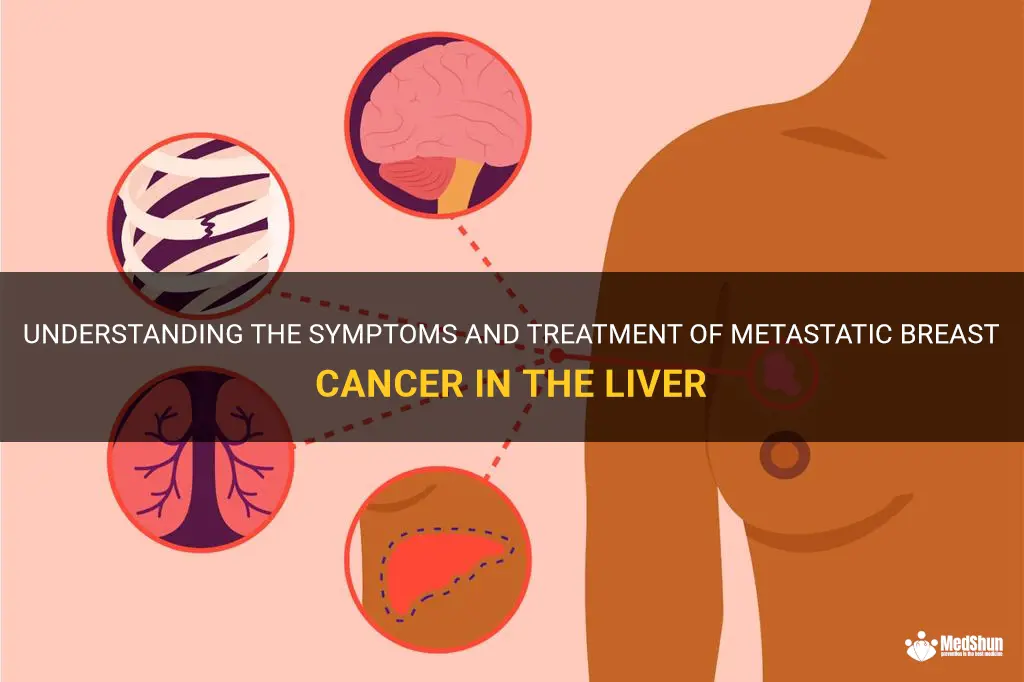
Metastatic breast cancer, specifically when it spreads to the liver, is a complex and challenging condition that requires aggressive and individualized treatment. The presence of breast cancer cells in the liver can cause a range of symptoms and complications, making its treatment crucial for improving patient outcomes. In this article, we will delve into the various symptoms of metastatic breast cancer in the liver and explore the different treatment options available to effectively manage this advanced stage of the disease.
| Characteristics | Values |
|---|---|
| Type of cancer | Breast cancer |
| Stage of cancer | Metastatic |
| Metastasis | Liver |
| Symptoms | - Abdominal pain |
| - Jaundice | |
| - Loss of appetite | |
| - Weight loss | |
| - Fatigue | |
| Treatment options | - Surgery |
| - Chemotherapy | |
| - Hormone therapy | |
| - Targeted therapy | |
| - Radiation therapy | |
| - Liver-directed therapy | |
| Prognosis | Varies depending on |
| the stage of cancer, | |
| overall health of the | |
| patient, and response | |
| to treatment | |
| Survival rate | Varies depending on |
| multiple factors such | |
| as the stage of cancer, | |
| overall health of the | |
| patient, and response | |
| to treatment | |
| Supportive care | - Pain management |
| - Nutrition guidance | |
| - Emotional support | |
| - Palliative care | |
| - Symptom management |
What You'll Learn
- What are the common symptoms of metastatic breast cancer spreading to the liver?
- How does the treatment approach differ for metastatic breast cancer patients with liver involvement compared to those without liver involvement?
- What are the available treatment options for metastatic breast cancer patients with liver involvement?
- How does the prognosis or survival rate change for metastatic breast cancer patients with liver involvement?
- Are there any promising new treatment developments or clinical trials for metastatic breast cancer patients with liver involvement?

What are the common symptoms of metastatic breast cancer spreading to the liver?
Metastatic breast cancer occurs when cancer cells from the breast spread to other parts of the body, including the liver. When breast cancer spreads to the liver, it is known as liver metastasis or stage IV breast cancer. Detecting liver metastasis early is crucial for treatment and prognosis. Understanding the common symptoms of this condition can help individuals recognize and seek medical attention promptly.
One common symptom of metastatic breast cancer spreading to the liver is abdominal pain or discomfort. The liver is located in the upper right quadrant of the abdomen, and when cancer cells invade the liver, it can cause pain or a feeling of fullness in that area. The pain may be dull or sharp and can worsen over time.
Jaundice is another symptom often seen in liver metastasis. Jaundice is a condition characterized by a yellowing of the skin and eyes, due to a build-up of bilirubin, a yellow pigment produced by the liver. When liver cells are damaged by cancer, they may not be able to process bilirubin properly, leading to jaundice. In some cases, the urine may also appear dark and the stool may be pale.
Fatigue and weakness are common symptoms of liver metastasis. Cancer cells take up space in the liver, disrupting its normal functioning. The liver plays a crucial role in filtering and detoxifying the blood, as well as producing proteins and storing energy. When the liver is affected by cancer, these functions can be impaired, leading to fatigue and weakness.
Loss of appetite and unintentional weight loss can also be signs of metastatic breast cancer in the liver. The liver produces bile, which helps with digestion and absorption of nutrients. When cancer cells invade the liver, they can disrupt this process, leading to a decrease in appetite and subsequent weight loss.
In some cases, liver metastasis can cause ascites, which is the accumulation of fluid in the abdominal cavity. This can result in a distended or swollen abdomen. Ascites can also cause shortness of breath, as the excess fluid puts pressure on the diaphragm, making it difficult to breathe.
It is important to note that the symptoms mentioned above are not exclusive to liver metastasis from breast cancer. They can also mimic other conditions, such as hepatitis or cirrhosis. Therefore, it is crucial for individuals experiencing these symptoms to seek medical attention for a proper diagnosis.
In conclusion, there are several common symptoms of metastatic breast cancer spreading to the liver. These include abdominal pain or discomfort, jaundice, fatigue and weakness, loss of appetite and unintentional weight loss, as well as the development of ascites. Recognizing these symptoms and seeking medical attention promptly can aid in early detection and improve the prognosis for individuals with metastatic breast cancer in the liver.
Reimagining Breast Cancer Treatment: A Fresh Perspective on Fighting the Disease
You may want to see also

How does the treatment approach differ for metastatic breast cancer patients with liver involvement compared to those without liver involvement?
Metastatic breast cancer refers to breast cancer that has spread to other parts of the body beyond the breast and nearby lymph nodes. One common site of metastasis is the liver. When breast cancer spreads to the liver, it can affect the treatment approach and prognosis for patients. In this article, we will discuss how the treatment approach differs for metastatic breast cancer patients with liver involvement compared to those without liver involvement.
Liver involvement in metastatic breast cancer can have significant implications for treatment decisions. The liver is a vital organ responsible for detoxification, metabolism, and the production of proteins essential for blood clotting. When cancer spreads to the liver, it can impair its function and lead to further complications.
In cases where breast cancer has spread only to the liver, treatment options generally focus on controlling the spread of cancer, managing symptoms, and preserving the liver function. The primary goal is to target the cancer cells in the liver while minimizing damage to healthy liver tissue. There are several treatment modalities available, including systemic therapy (chemotherapy, targeted therapy, hormone therapy), local treatments (radiofrequency ablation, radiation therapy), and potentially surgical procedures (liver resection or transplantation).
Systemic therapy plays a crucial role in the treatment of metastatic breast cancer with liver involvement. Chemotherapy drugs, such as taxanes, anthracyclines, and capecitabine, can be effective in controlling the growth of cancer cells and reducing tumor burden in the liver. Targeted therapies, such as HER2-targeted drugs (trastuzumab, pertuzumab) and CDK4/6 inhibitors (palbociclib, ribociclib), are also commonly used when specific genetic mutations or receptor overexpression are present. Hormone therapy, such as tamoxifen or aromatase inhibitors, may be used when the breast cancer is hormone receptor-positive.
Local treatments, such as radiofrequency ablation (RFA) or radiation therapy, can be used to directly target liver tumors while sparing healthy liver tissue. RFA uses heat to destroy cancer cells, and it is suitable for patients with a limited number of liver tumors. Radiation therapy uses high-energy radiation to kill cancer cells and can be utilized to treat large or multiple liver metastases. In some cases, liver resection or transplantation may be considered for patients with a small number of liver metastases and preserved liver function.
In contrast, treatment approaches for metastatic breast cancer patients without liver involvement may focus on controlling cancer spread to other sites, such as bones, lungs, or distant lymph nodes. The liver is an important consideration for these patients, as it can affect the metabolism and clearance of chemotherapy drugs. However, the primary goal of treatment may differ, with a focus on managing symptoms and prolonging survival rather than specifically targeting liver metastases.
It is important to note that the treatment approach for metastatic breast cancer is highly individualized and depends on various factors, including the extent of liver involvement, overall health status, genetic profile of the cancer, and patient preferences. Treatment decisions should be made in collaboration between the patient and their healthcare team, taking into account the risks and benefits of each treatment option.
In conclusion, the treatment approach for metastatic breast cancer patients with liver involvement differs from those without liver involvement. For patients with liver metastases, the treatment focuses on targeting cancer cells in the liver while preserving liver function. Systemic therapies, local treatments, and potentially surgical procedures are utilized to achieve this goal. On the other hand, treatment for patients without liver involvement may prioritize managing symptoms and controlling cancer spread to other sites. It is crucial for healthcare providers to develop personalized treatment plans that consider the unique characteristics and needs of each patient.
Revolutionary Advances in the Screening, Diagnosis, and Treatment of Breast Cancer
You may want to see also

What are the available treatment options for metastatic breast cancer patients with liver involvement?
Metastatic breast cancer occurs when breast cancer cells spread to other parts of the body, such as the liver. Liver involvement in metastatic breast cancer can present various challenges and requires a tailored treatment approach. The available treatment options for patients with liver involvement include systemic therapy, liver-directed therapies, and supportive care.
Systemic therapy is the main treatment approach for metastatic breast cancer, regardless of liver involvement. It includes chemotherapy, hormone therapy, and targeted therapy. Chemotherapy uses drugs to kill cancer cells throughout the body. Various chemotherapy regimens are available, and the choice depends on factors such as the tumor subtype, response to previous treatments, and overall health of the patient. For hormone receptor-positive breast cancer, hormone therapy is often the first line of treatment. It involves medications that block the effects of estrogen or lower its production in the body. Targeted therapy is a treatment that targets specific molecules in cancer cells to inhibit their growth. Examples of targeted therapies used in metastatic breast cancer with liver involvement include drugs like Palbociclib, Pertuzumab, and Trastuzumab.
Liver-directed therapies are treatments that directly target the liver tumors. They may be used in combination with systemic therapy to achieve better outcomes. Some liver-directed therapies include radiofrequency ablation, microwave ablation, and transarterial chemoembolization. Radiofrequency and microwave ablation use heat or microwave energy to destroy tumors in the liver. Transarterial chemoembolization is a procedure in which chemotherapy drugs are injected directly into the blood vessels supplying the liver tumors, followed by the injection of tiny particles to block the blood flow to the tumors, thereby depriving them of nutrients and oxygen.
In addition to medical treatments, supportive care also plays a vital role in the management of metastatic breast cancer with liver involvement. Supportive care focuses on providing relief from symptoms and improving the patient's quality of life. It involves the use of medications to manage pain, control nausea and vomiting, and address other side effects of treatment. Palliative care services may also be offered to help patients and their families cope with the emotional and psychological challenges associated with advanced cancer.
Overall, the treatment of metastatic breast cancer with liver involvement requires a multidisciplinary approach, involving medical oncologists, radiation oncologists, hepatobiliary surgeons, and supportive care specialists. The choice of treatment depends on various factors, including the extent and location of liver involvement, the tumor subtype, previous treatments received, and the overall health and preferences of the patient. Treatment decisions should be made in close consultation with the patient, taking into account their goals, values, and individual circumstances.
Understanding the Options for Breast Cancer Treatment in Kenosha
You may want to see also

How does the prognosis or survival rate change for metastatic breast cancer patients with liver involvement?
Metastatic breast cancer occurs when breast cancer cells spread to other parts of the body, such as the liver. Liver involvement in metastatic breast cancer can have a significant impact on the prognosis and survival rate of patients. In this article, we will explore how the prognosis or survival rate changes for metastatic breast cancer patients with liver involvement.
The liver is a common site for breast cancer metastasis, and its involvement can occur at various stages of the disease. Liver involvement may be detected at the time of the initial diagnosis or may develop later during the course of the disease. The extent of liver involvement, the number and size of liver metastases, and other factors can influence the prognosis and survival rate of patients.
One important factor to consider is the overall stage of metastatic breast cancer. The American Joint Committee on Cancer (AJCC) staging system classifies metastatic breast cancer into several stages based on the extent of spread to distant sites, including the liver. Patients with liver involvement in early-stage breast cancer may have a better prognosis compared to those with late-stage involvement.
Another important factor is the response to treatment. Liver involvement in breast cancer can be treated with a variety of treatment options, including systemic therapies such as chemotherapy, targeted therapy, hormone therapy, and immunotherapy. The response to these treatments can vary among patients and can greatly impact prognosis. For example, patients who have a good response to chemotherapy may have a better prognosis compared to those who do not respond well.
The number and size of liver metastases can also affect prognosis. Patients with a single liver metastasis may have a better prognosis compared to those with multiple metastases. Additionally, the size of the metastases can influence prognosis, with smaller metastases generally associated with a better outcome.
The presence of other metastatic sites can also impact prognosis. Breast cancer can spread to other organs such as the lungs, bones, and brain. The presence of multiple metastatic sites, in addition to liver involvement, may indicate a more aggressive disease and may be associated with a poorer prognosis.
It is important to note that each patient is unique, and the prognosis and survival rate can vary widely. Factors such as age, overall health, and individual response to treatment can also influence prognosis. In some cases, patients with liver involvement may have a long-term survival, especially with advancements in treatment options and personalized medicine.
In conclusion, the prognosis or survival rate for metastatic breast cancer patients with liver involvement can vary depending on several factors, including stage of disease, response to treatment, number and size of liver metastases, presence of other metastatic sites, and individual patient characteristics. Early detection, effective treatment, and ongoing monitoring can help improve outcomes for these patients. It is essential for patients with liver involvement in metastatic breast cancer to work closely with their healthcare team to develop an individualized treatment plan and receive appropriate support throughout their journey.
The Benefits of Breast Cancer Chemotherapy Treatment Before Surgery
You may want to see also

Are there any promising new treatment developments or clinical trials for metastatic breast cancer patients with liver involvement?
Metastatic breast cancer is a challenging condition, particularly when it involves the liver. Liver metastases occur in about 60% of women with metastatic breast cancer, and they contribute to poor prognosis and reduced quality of life. However, there have been promising developments in treatment options and ongoing clinical trials that offer hope for patients with this specific condition.
One of the most significant advances in recent years is the introduction of targeted therapies that specifically address liver metastases in breast cancer patients. One such therapy is called trastuzumab emtansine, also known as T-DM1. This drug is an antibody-drug conjugate that combines the action of trastuzumab (Herceptin) with a chemotherapy agent called emtansine. T-DM1 has shown impressive results in clinical trials, improving overall survival and progression-free survival in women with HER2-positive breast cancer metastasized to the liver.
In addition to targeted therapies, new approaches to local liver-directed therapy have also shown promise. One such approach is hepatic artery infusion (HAI) chemotherapy, which involves directly delivering chemotherapy drugs to the liver through the hepatic artery. This allows for higher concentrations of the drugs in the liver while minimizing systemic side effects. HAI chemotherapy has been shown to improve liver-specific outcomes and overall survival in patients with liver metastases from colorectal cancer, and ongoing clinical trials are investigating its efficacy in breast cancer patients as well.
Furthermore, immunotherapy has emerged as a potential treatment option for metastatic breast cancer with liver involvement. Immune checkpoint inhibitors, such as pembrolizumab and nivolumab, have shown promise in other types of cancer and are now being explored in breast cancer patients with liver metastases. Clinical trials evaluating the combination of immunotherapy and targeted therapies are ongoing and may provide new treatment options for these patients.
It is important to note that clinical trials are crucial for advancing the field of metastatic breast cancer treatment. These trials allow researchers to evaluate new approaches, compare different treatments, and identify the most effective strategies for specific patient groups. Patients with metastatic breast cancer involving the liver are encouraged to consider participating in clinical trials, as they offer access to cutting-edge treatments that may not yet be available to the general population.
In summary, there are promising new treatment developments and ongoing clinical trials for metastatic breast cancer patients with liver involvement. Targeted therapies, such as trastuzumab emtansine, show great potential in improving outcomes for HER2-positive breast cancer patients with liver metastases. Liver-directed therapies, including hepatic artery infusion chemotherapy and immunotherapy, are also being explored and may offer additional treatment options. Patients should consult with their healthcare providers and consider participating in clinical trials to access these advancements in treatment.
The Power of Storytelling: Exploring Breast Cancer Treatment through Documentary Filmmaking
You may want to see also
Frequently asked questions
Some common symptoms of metastatic breast cancer in the liver include abdominal pain or discomfort, yellowing of the skin and eyes (jaundice), unexplained weight loss, fatigue, and an enlarged liver.
Treatment options for metastatic breast cancer in the liver may include surgery to remove the tumor(s) in the liver, radiation therapy to target and kill cancer cells, targeted therapy drugs that specifically target cancer cells, chemotherapy to destroy cancer cells throughout the body, and hormone therapy to block the effects of estrogen in hormone receptor-positive breast cancer.
Unfortunately, metastatic breast cancer in the liver cannot be cured. However, with proper treatment and management, the progression of the disease can be slowed and symptoms can be controlled, improving overall quality of life and potentially extending survival.
Yes, there are often clinical trials and experimental treatments available for metastatic breast cancer in the liver. These trials can offer new treatment options and the opportunity to access cutting-edge therapies that are not yet widely available. It is important to speak with a healthcare provider and explore all available options to determine if clinical trials are a suitable option.







